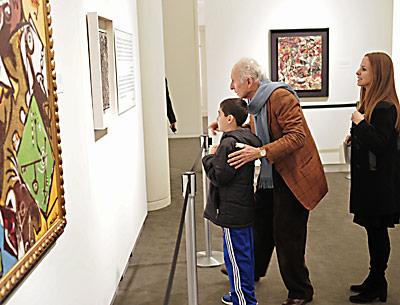Pollock’s One-Night Stand

Elizabeth Taylor’s diamonds weren’t the only items attracting interest at New York City auction houses last week. On Dec. 13, many well-heeled city and East End art aficionados gathered on the top floor of Sotheby’s Upper East Side auction house to view a small but strong collection of Jackson Pollock works rarely seen outside of the houses of the private collectors who own them.
A red carpet with skeins of dripped white and black paint greeted the guests in the lobby and at the entrance to the exhibit. Appetizers had a graphic and abstract quality, brought out even more by the dripped painted design on their trays. A jazz combo played a selection of music one can only hope would have satisfied Pollock, a very opinionated music connoisseur.
The event was a preview to a number of programs to mark the centennial birthday of the artist on Jan. 28. He died on Aug. 11, 1956.
In the coming year, the Pollock-Krasner House and Study Center in Springs is hoping to raise an endowment to ensure its operation and programs will continue in perpetuity. The Pollock-Krasner Foundation has pledged $1 million in a matching challenge grant to jump-start the process. The house is owned and operated by the Stony Brook Foundation, which is a nonprofit affiliate of Stony Brook University.
Laurie Anderson, Chuck Close, Eric Fischl, April Gornik, Marcia Gay Harden, Ed Harris, Dorothy Lichtenstein, Lisa Perry, Ellen Phelan, Lou Reed, Joel Shapiro, and Patti Smith served as honorary hosts of the Dec. 13 event. Ms. Smith, who has a son named Jackson and referred to Pollock in one of her earlier songs, read passages in which the artist described his painting process and others by Lee Krasner discussing how the couple decided to move to Springs.
The artworks themselves were a small but often striking group. One early painting was composed of wild roses that Pollock painted on Martha’s Vineyard while visiting Thomas Hart Benton in 1937. The small oil on canvas was given to a young folk singer Pollock fancied as a remembrance after she broke off their relationship.
Rick Friedman, a collector and the organizer of the ArtHamptons art fair, lent another early work. The pencil drawing on paper of a hybrid creature may have been inspired by Picasso’s “Guernica,” which was on view in New York around 1940, when the work was executed.
Also on view was the drip painting “Number 22” from 1949, a rather dense configuration of red, yellow, black, and white with a hint of teal and green. Eugene V. Thaw, who with Francis V. O’Connor compiled the Pollock catalogue raisonné, contributed with his wife a restrained composition of oil and enamel on just a strip of canvas, somehow cool and hot at the same time with its lively yet graceful markings. The latest work was a drawing of colored inks on Japanese paper from 1951. It was known as a productive year for the artist as a draftsman, according to Mr. O’Connor and Mr. Thaw. The support gives the painting a shimmery and watery effect.
An example of one of the Pollock and Krasner household’s New Year’s cards was also included. The screen print card has an inscription by Pollock and was made in 1949. Ms. Harrison said Pollock was typically the one who designed the cards for the couple.
Other events next year will include a Stony Brook Foundation gala on April 25 at Chelsea Piers at which Ed Harris, who directed and starred in the film “Pollock,” will be honored. “Ed Harris really took on Pollock as a project. He acted, directed, contributed to the script and the film with his own money,” Ms. Harrison said. “It was really a labor of love.” She added that his simulation of Pollock’s creative act was plausible. “He pulled it off.”
There will also be two exhibits at the house and study center. The first one, “The Persistence of Pollock,” will feature works that reflect Pollock’s powerful impact and attest to his continued influence on contemporary artists, according to its organizers Ms. Harrison and Bobbi Coller, the chairwoman of the Pollock-Krasner House advisory board. Artists will include Janine Antoni, Robert Arneson, Mike Bidlo, James Brooks, Arnold Chang, Joe Fig, Red Grooms, Ray Johnson, and Norman Rockwell. It will run from May 3 to July 28.
The next exhibit, “Men of Fire: José Clemente Orozco and Jackson Pollock,” will be presented in conjunction with the Hood Museum of Art at Dartmouth College in Hanover, N.H., where Orozco, a Mexican muralist, painted a fresco cycle from 1932 to 1934. Some significant museums and art collections will lend works to the show, which will run from Aug. 2 to Oct. 27, after a showing at the Hood Museum in the early summer.
Ms. Harrison said in addition to Orozco, the exhibits will show how Pollock was influenced by the American regionalism of Benton and Alfonso Ossorio’s more cosmopolitan European sources and contemporaries as well as his own exposure to international modernism at the Museum of Non-Objective Art. The museum, started by Hilla Rebay, became the Solomon R. Guggenheim Museum. In 1943, while Pollock was employed there doing odd jobs, he saw works by Wassily Kandinsky and others that shaped his own art.
Pollock’s own influence on artists will be explored through works that range from outright homage to more indirect references. Mr. Fig recreates artist studios in smaller-scale sculptures that include painstaking evocations of the subject’s art. Rockwell caught the spirit of Pollock in a cover for The Saturday Evening Post called “Connoisseur” that included Rockwell’s own version of a drip painting. Mr. Arneson, who created some 80 pieces related to Pollock in ceramics as well as drawings, will be represented with a piece from that series. Ms. Antoni, using hair dye on the floor, co-opted the idea of action painting with her own head and hair as the brush.
